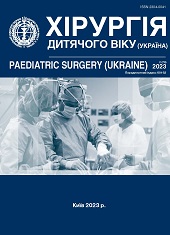Experience in extended pancreatoduodenal resections performing in patients with malignant neoplasms of the pancreatobiliary zone complicated by obstructive jaundice syndrome
DOI:
https://doi.org/10.15574/PS.2023.79.35Keywords:
lymph node dissection, postoperative complications, pancreatic cancer, mechanical jaundice, pancreatoduodenal resectionAbstract
Despite the results of randomized trials, mortality and survival rates, clinical aspects of extended pancreaticoduodenal resection remain a subject of debate.
Purpose - to determine the effect of the pancreaticoduodenal resection volume expanding on the results of surgical intervention.
Materials and methods. The results of surgical treatment of 101 patients with malignant neoplasms of the pancreatobiliary zone, complicated by mechanical jaundice syndrome, were analyzed. Depending on the volume of lymph node dissection, patients were randomized into two cohorts. The main group included 33 (32.7%) patients who underwent an extended version of pancreatoduodenal resection; the comparison group included 68 (67.3%) patients who underwent standard pancreaticoduodenal resection.
Results. Intraoperative blood loss in extended interventions somewhat exaggerated the volume of blood loss in standard ones, however, there was no statistically significant advantage (522±165) ml versus (468±124) ml (p>0.05). In patients after extended surgical interventions, the average debit of lymph through the drains was (512±26) ml/day, which was almost 46.2% higher than the average amount of lymph outflow through the drains in patients after standard ((236 ± 31) ml/day) and was statistically confirmed (p<0.05). Secretory diarrhea lasting more than 2 weeks, as a complication of extended pancreatoduodenal resection, occurred in 7 (21.2%) patients, and after the standard one - only in 3 (4.4%) (p<0.05). A life-threatening postoperative complication as failure of the pancreatodigestive anastomosis due to pancreatic necrosis of the pancreatic stump complicated the course of the postoperative period in 9 (13.2%) patients after standard interventions, while after extended interventions it was diagnosed in 4 (12.1%) patients. Mortality after standard pancreatoduodenal resection was 7.4% (5 patients), after extended resections - 6.1% (2 patients).
Conclusions. On the one hand, the obtained results demonstrate more difficult conditions of extended pancreaticoduodenal resection performing, and, on the other hand, the absence of statistically significant differences with standard intervention in terms of the frequency of complications.
The research was carried out in accordance with the principles of the Helsinki Declaration. The study protocol was approved by the Local Ethics Committee of the participating institution. The informed consent of the patient was obtained for conducting the studies.
No conflict of interests was declared by the authors.
References
Eshmuminov D, Aminjonov B, Palm RF et al. (2023). FOLFIRINOX or Gemcitabine-based Chemotherapy for Borderline Resectable and Locally Advanced Pancreatic Cancer: A Multi-institutional, Patient-Level, Meta-analysis and Systematic Review. Ann Surg Oncol. https://doi.org/10.1245/s10434-023-13353-2; PMid:37020094 PMCid:PMC10250524
Lambert A, Schwarz L et al. (2019). An update on treatment options for pancreatic adenocarcinoma Ther Adv Med Oncol. 11: 1-43. https://doi.org/10.1177/1758835919875568; PMid:31598142 PMCid:PMC6763942
Lin Q, Zheng S, Yu X, Chen M, Zhou Y, Zhou Q et al. (2023). Standard pancreatoduodenectomy versus extended pancreatoduodenectomy with modified retroperitoneal nerve resection in patients with pancreatic head cancer: a multicenter randomized controlled trial. Cancer Communications. 43: 257-275. https://doi.org/10.1002/cac2.12399; PMid:36579790 PMCid:PMC9926959
Maeda S, Unno M, Yu J. (2019). Concomitant pancreatic neuroendocrine tumors in hereditary tumor syndromes: who, when and how to operate? J Pancreatol. 2: 100-106. https://doi.org/10.1097/JP9.0000000000000028
Muraviov PT, Zaporozhchenko BS, Khimich SD, Borodaev IE, Shevchenko VG. (2023). Results of the application of an improved prognostic and therapeutic algorithm for the provision of radical surgical care to patients with mechanical jaundice of benign and malignant genesis. Paediatric Surgery (Ukraine). 1 (78): 88-95. https://doi.org/10.15574/PS.2023.78.88
Panagiotakis E, Selzer T, Böhm G et al. (2023). Preoperative hemoglobin levels, extended resections and the body mass index influence survival after pancreaticoduodenectomy. Langenbecks Arch Surg. 408: 124. https://doi.org/10.1007/s00423-023-02863-y; PMid:36935457
Wang W, He Y, Wu L, Ye L, Yao L, Tang Z. (2019). Efficacy of extended versus standard lymphadenectomy in pancreatoduodenectomy for pancreatic head adenocarcinoma. An update meta-analysis, Pancreatology. 19 (8): 1074-1080. https://doi.org/10.1016/j.pan.2019.10.003; PMid:31668841
Wang W, Lou W, Xu Z et al. (2022). Long-term outcomes of standard versus extended lymphadenectomy in pancreatoduodenectomy for pancreatic ductal adenocarcinoma: A Chinese multi-center prospective randomized controlled trial. Journal of Advanced Research. https://doi.org/10.1016/j.jare.2022.09.011; PMid:36198383 PMCid:PMC10334112
Zhu L, Yang Y, Cheng H, Cai Z, Tang N, Mao L, Fu X, Qiu Y. (2023). The role of preoperative biliary drainage on postoperative outcome after pancreaticoduodenectomy in patients with obstructive jaundice. Gland Surg. URL: https://gs.amegroups.com/article/view/112678/html. https://doi.org/10.21037/gs-22-648; PMid:37284706 PMCid:PMC10240431
Downloads
Published
Issue
Section
License
Copyright (c) 2023 Paediatric Surgery (Ukraine)

This work is licensed under a Creative Commons Attribution-NonCommercial 4.0 International License.
The policy of the Journal “PAEDIATRIC SURGERY. UKRAINE” is compatible with the vast majority of funders' of open access and self-archiving policies. The journal provides immediate open access route being convinced that everyone – not only scientists - can benefit from research results, and publishes articles exclusively under open access distribution, with a Creative Commons Attribution-Noncommercial 4.0 international license(СС BY-NC).
Authors transfer the copyright to the Journal “PAEDIATRIC SURGERY.UKRAINE” when the manuscript is accepted for publication. Authors declare that this manuscript has not been published nor is under simultaneous consideration for publication elsewhere. After publication, the articles become freely available on-line to the public.
Readers have the right to use, distribute, and reproduce articles in any medium, provided the articles and the journal are properly cited.
The use of published materials for commercial purposes is strongly prohibited.

